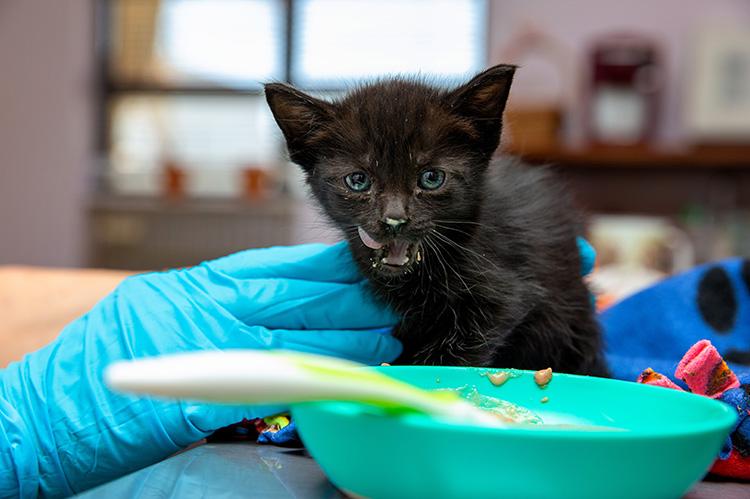Weaning foster kittens

Weaning
Weaning may begin at 3 ½ to 4 weeks of age. Start by offering the kittens formula on a spoon. Once they are lapping off the spoon, try putting some formula in a saucer. As they master lapping up the formula out of the saucer, you can gradually add a small amount of canned food to the formula in the saucer, making a gruel. Increase the amount of canned food slowly, adding more food and less formula. Some kittens catch on right away, others may take a few days. To be sure the kittens are getting enough food, you may need to continue bottle feeding them a few times a day, until they are eating well on their own. Be sure to feed them what they need to be full, but don’t overfeed them.
Monitor the kittens’ stools to make sure they are tolerating and digesting the gruel mix well. If the kittens have loose stools, reduce the amount of canned food and increase the formula until their systems have adjusted. As the kittens adjust to the gruel mix and you are adding more canned food to their diet, you can also add more water to the formula mix. If you are using KMR formula, add an extra measure of water when preparing the formula. Instead of 1 part formula to 2 parts water, mix 1 part formula to 3 or 4 parts water. For the Hoskins formula, you may add an extra ounce of water to the recipe.
As the kittens eat more food and less formula, you will need to have a bowl of fresh water available to them at all times to keep them well hydrated. At this time, you may also add dry food to their diet. Add some of the watered-down formula mix to the dry food to entice the kittens to eat it. Gradually reduce the formula and let them eat the food dry. Again, keep watch on the kittens’ stools to make sure they are tolerating the food well. If diarrhea or constipation persists with the change in diet, contact your medical staff.
Weight and hydration
Continue to weigh your kittens daily, preferably at the same time each day, using a kitchen or postal scale. Kittens should gain about ½ ounce every day or 3 to 4 ounces per week. By eight weeks, most kittens weigh about 2 pounds. Enter their daily weights in the logbook. If the kittens are not gaining weight or are losing weight, contact your medical staff right away.
A well-fed kitten should be properly hydrated. To test a kitten’s hydration, pull up on the skin at the scruff of the neck. The skin should bounce back easily. If it doesn’t bounce back, or goes back down slowly, the kitten may be dehydrated. If the kitten appears dehydrated, contact your medical staff.
Litter box training
When they are about four weeks of age, kittens can be introduced to the litter box. At that age, they will begin to play in, dig through and explore loose, soft materials such as dirt or litter. As a result of this investigative digging, kittens begin to relieve themselves in these materials. So, kittens do not have to be taught by either their mothers or humans to relieve themselves in soft, loose materials, or to dig and bury their waste. Kittens are simply born knowing how to do it.
It’s not necessary to take kittens to the litter box and move their paws back and forth in the litter. Doing so may actually be an unpleasant experience for them, causing them to have some negative associations with the litter box.
Use a small cardboard box or plastic litter box with just enough clay litter to cover the bottom. Don’t use clumping litter. The reason for this is that very young kittens tend to taste their litter and play in it. If you use clumping litter, the dust from the litter can solidify in their respiratory or digestive tracts.
Adding a used cotton ball (from when you helped them urinate) to the box will help them get the idea of what to do next. Put the kittens in the box, allowing them to get the feel for the litter. Natural instinct will generally prevail and the kittens will begin investigating, scratching, and, within a few days, using the box.
Regarding cleanliness: Feces should be scooped out of the litter box daily. The number of kittens will determine how often the litter needs to be dumped and completely changed. Twice a week is a general guideline, but you may need to change it more or less often, depending on the circumstances. If you notice any odor or if much of the litter is wet, it is time to change all the litter.
When washing the litter box, do not use strong-smelling chemicals or cleaning products because the smell of vinegar, bleach or pine cleaners may cause cats to avoid using the litter box. Washing with soap and water should be sufficient. Letting the container air-dry is also a good idea, but it will be necessary to have a back-up litter box while the other one is being cleaned.